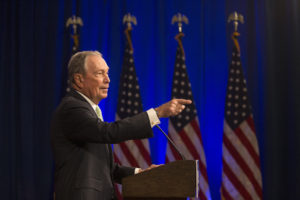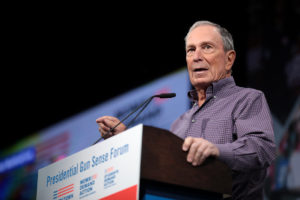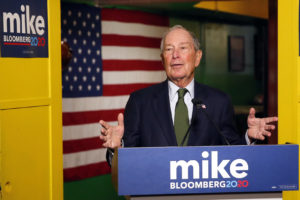Reining in CEO Pay Could Start With the Kingpins of Nonprofits
Nonprofits don’t have the political clout of their corporate counterparts, so balancing the CEO-worker pay ratio should be easier. Image: Adobe
Image: Adobe
How rich have America’s super rich become? The annual compensation of Steve Schwarzman, the chief exec of the private-equity colossus Blackstone Inc., offers up one telling yardstick.
In 2023, we learned earlier this year, Schwarzman’s take-home actually fell some 30 percent off what he collected the year before. But Schwarzman’s overall payday for that year, even after that tanking, still amounted to a jaw-dropping $896.7 million.
The current personal net worth of Blackstone’s CEO? The Bloomberg Billionaires Index puts that figure at a sweet $42.3 billion.
Schwarzman’s current political net worth? That remains to be seen. In the 2020 presidential election cycle, this Wall Street titan spent over $27 million on donations to his favorite office-seekers, over five times what he spent in the 2016 election cycle. Since 2020, Schwarzman’s personal fortune — what he has available to shower down on his election-day favorites — has more than doubled.
Today, the latest Forbes tally tells us, some 813 billionaires call the USA home.
The total wealth of billionaires worldwide, over that same span, has more than tripled, from $76 to $233 billion, according to just-published Forbes data. Four years ago, Forbes counted more billionaires in the United States — 614 — than in any other nation. Today, the latest Forbes tally tells us, some 813 billionaires call the USA home.
These billionaires — and the mere centi-millionaires so yearning for billionaire status — aren’t just prospering. They’re exerting an unmatched influence on our politics and our future.
Americans of modest means, back in the early 1900s, confronted an eerily similar political situation. They would come to understood, as the great U.S. Supreme Justice Louis Brandeis once put it, that “we can have democracy in this country or we can have great wealth concentrated in the hands of a few, but we can’t have both.” They did their best to de-concentrate the nation’s wealth — and made some serious progress.
By the middle of the 20th century, thanks to that progress, America’s richest were facing a 91 percent federal tax on their income over $400,000, the equivalent of about $4.6 million today. Until 1980, those same rich also faced tax rates as high as 70 percent on the fortunes they willed at their deaths to their dearly beloveds.
Tax rates that stiff have all evaporated over the past half-century. America’s 400 richest today, analysts at the Biden White House have calculated, have of late been paying a minuscule 8.2 percent of their annual actual incomes in federal taxes.
How can we turn that 8.2 percent into something more like 82 percent? How can we start taxing the kingpins of the profiteering private sector at the same sort of high rates that helped the mid-20th-century United States give birth to history’s first mass middle class?
Maybe we need to start by focusing on the kingpins of the nonprofit sector.
No one in this nonprofit sector is, to be sure, currently pulling down anything close to the annual tens of millions now filling the pockets of our nation’s top corporate and financial execs. But many of our nonprofit sector’s chiefs — the top execs at major hospitals, universities, and foundations, for instance — are today taking home handsome rewards that dwarf the paychecks of their employees.
This past March, the Chronicle of Philanthropy took a look at annual chief executive compensation at 16 of America’s largest foundations. CEOs at these 16 nonprofit giants averaged $1.1 million.
On U.S. campuses, the Chronicle of Higher Education added earlier this year, top executive pay can run considerably higher than the compensation we see in foundation land. In 2021, the most recent year with data, some 21 presidents of private colleges and universities pocketed over $2 million.
Many of our nonprofit sector’s chiefs — the top execs at major hospitals, universities, and foundations, for instance — are today taking home handsome rewards that dwarf the paychecks of their employees.
That same year, the U.S. Senate Committee on Health, Education, Labor and Pensions reports, the top executives at 16 of America’s largest health care nonprofits “averaged more than $8 million in compensation” and took home over a combined $140 million.
The nonprofits that are shelling out all these hefty rewards, let’s keep in mind, are simultaneously enjoying assorted exemptions from federal, state, and local taxes. In other words, average American taxpayers are subsidizing the hefty compensation of America’s top nonprofit execs.
And that doesn’t sit too well with growing numbers of Americans working both inside and outside of our nation’s nonprofits. In Los Angeles, trade union activists in the hospital industry have been pushing for a local ordinance that would cap hospital executive pay at $450,000, the current take-home with expenses of the president of the United States.
“The primary concern of our major health providers,” the SEIU-United Healthcare Workers West union notes, “should be serving the community, not enriching individuals.”
But plenty of that enriching is going on, and not just in big cities like Los Angeles. In 2022, the CEO of Indiana’s largest nonprofit hospital-chain collected just over $4 million in compensation. That same nonprofit’s chief operating officer came up less than $1,000 shy of $2 million, and its chief financial officer made just over $1.5 million.
Nationally, observes the Lown Institute health-care think tank, nonprofit hospital CEOs are regularly making “as much as 60 times” more than workers at the nonprofits they manage.
How wide should that gap run? The world-renowned founder of modern management science, Peter Drucker, once told the federal Securities and Exchange Commission that no top execs should be making more than 20 times what they pay their workers.
“I have often advised managers that a 20-to-one salary ratio,” Drucker noted, “is the limit beyond which they cannot go if they don’t want resentment and falling morale to hit their companies.”
Earlier this year, U.S. Senator Bernie Sanders from Vermont joined a group of other lawmakers that included Maryland’s Chris Van Hollen and California’s Barbara Lee to introduce the latest federal legislative effort to translate Drucker’s wisdom into public policy. Their proposed “Tax Excessive CEO Pay Act” would raise tax rates on corporations with CEO-to-median worker pay ratios above 50 to 1.
“The American people are sick and tired of CEOs making nearly 350 times more than their average employees,” Senator Sanders opined at the bill’s unveiling, “while over 60 percent of Americans live paycheck to paycheck.”
“The American people are sick and tired of CEOs making nearly 350 times more than their average employees.”
This Sanders legislation has no chance of passage, of course, at our current historical moment. Our corporate big guns simply wield too much power on our contemporary political stage.
Our nonprofit world’s big guns, meanwhile, do have political clout as well, but not nearly as much as their corporate counterparts. So why not start focusing much more of our CEO-worker pay ratio fire on the nonprofit sector? Why not press for legislation that denies nonprofit status — and the tax breaks that come with it — to nonprofits that pay their top execs at any rate over Peter Drucker’s 20-times ratio?
Successful moves in that direction would send a powerful message: that our tax system should in no way reward enterprises that pay their execs unconscionably more than what they pay their workers.
That message, in turn, could lead to legislation that denies government contracts and subsidies to profit-making enterprises that lavish rewards on their chiefs at the expense of decent compensation for their mere employees.
Where could all this lead? Maybe to a tax code that subjects all income over a modest multiple of the minimum wage to at least the 91 percent tax on top-bracket income dollars in effect throughout the Eisenhower years. Taxing away income above that multiple would, in turn, help lock into place a much more equal America.
Could winning limits on nonprofit executive compensation actually set us on a path to reach that much more equal future? Any journey of a thousand miles, let’s never forget, always begins with a single simple step.
Your support matters…Independent journalism is under threat and overshadowed by heavily funded mainstream media.
You can help level the playing field. Become a member.
Your tax-deductible contribution keeps us digging beneath the headlines to give you thought-provoking, investigative reporting and analysis that unearths what's really happening- without compromise.
Give today to support our courageous, independent journalists.






You need to be a supporter to comment.
There are currently no responses to this article.
Be the first to respond.